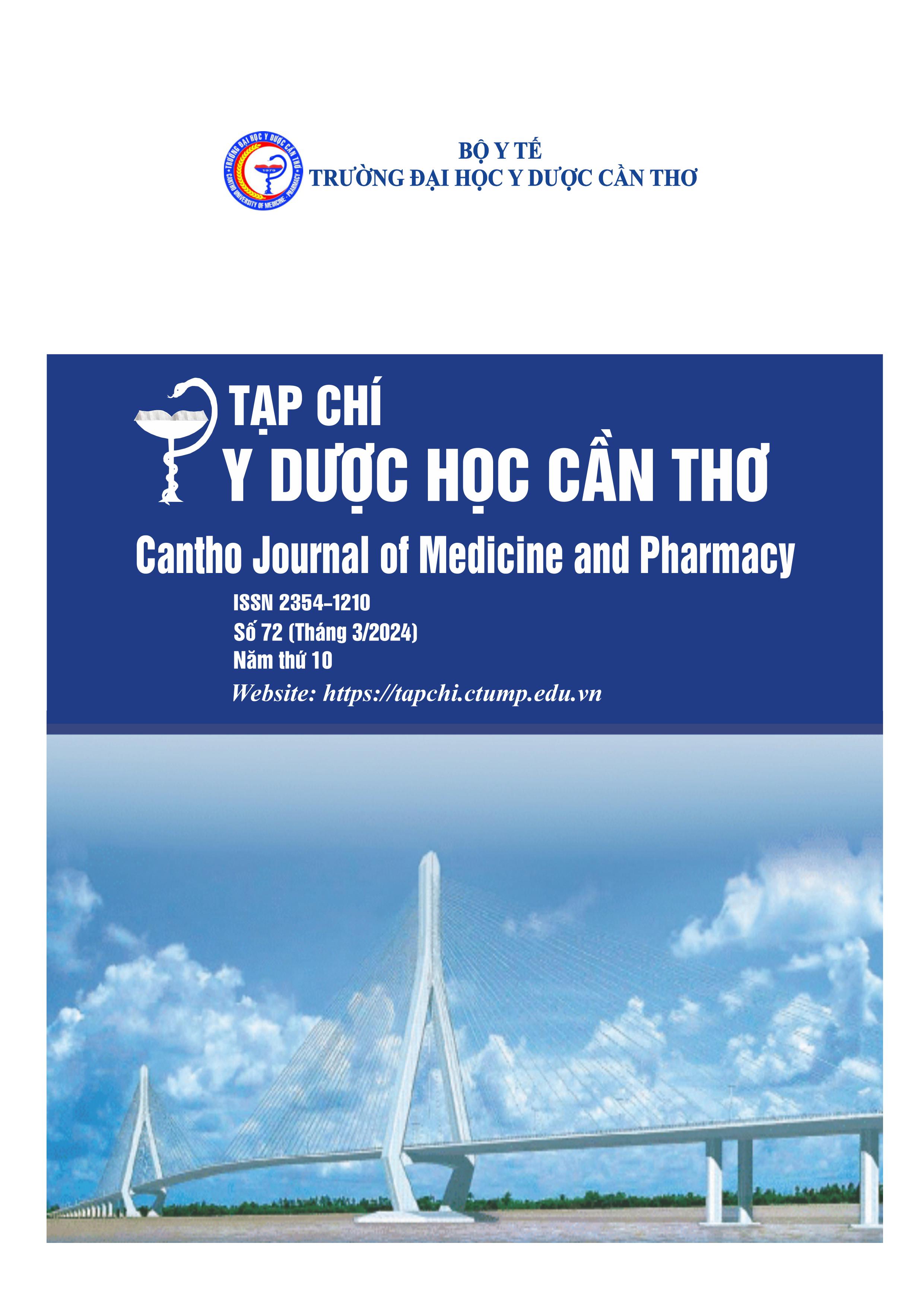EVALUATING THE RESULT OF THE RECOVERY OF MOTOR FUNCTION WITH THE REMEDY OF BU YANG HUAN WU TANG COMBINED WITH ELECTRO-ACUPUNCTURE, ACUPRESSURE MASSAGE, AND EMBEDDING IN PATIENTS AFTER CEREBRAL INFARCTION QI XU XUE YU SYNDROME IN CAN THO CITY
Main Article Content
Abstract
Background: Stroke is a topical issue in countries worldwide, of which the majority is caused by cerebral infarction. The disease often leaves serious sequelae for the patient, family, and society. Recently, the recovery of motor function after a stroke using modern medicine combined with traditional medicine has made clear progress. In recent years, thread implantation has been considered a method combining traditional medicine and modern medicine with outstanding advantages and effectiveness in disease treatment. Objective: To evaluate the results of recovery of motor function with the remedy Bu Yang Huan Wu Tang combined with electro-acupuncture, acupressure massage, and embedding in patients after cerebral infarction Qi Xu Xue Yu syndrome. Materials and methods: Randomized clinical intervention study on 53 patients after cerebral infarction with pneumothorax and blood stasis with motor sequelae who came for examination and inpatient treatment in Can Tho City from February 2023 to February 2024. Using the research protocol to evaluate results based on the Barthel and Rankin scale after 14 days of treatment. Results: Before treatment, 100% of patients had Barthel scores classified as weak or poor. After treatment, all patients' symptoms improved; 49.1% rated good, and 34% rated fair. Before treatment, the average Barthel score was 20.47± 13.24; following treatment, it increased to 77.75± 14.85, and then to 57.28±1.61 (p<0.001). Before treatment, 100% of patients were at levels 4 and 5, according to Rankin; after treatment, the rate of grade 3 or lower reached 79.2%. Results after 14 days of treatment were 79.2% effective (p<0.001). Conclusion: The research regimen helps improve patients' motor function and ability to do daily activities. Research with a larger sample size is needed to be more convincing.
Article Details
Keywords
ischemic stroke, Bu Yang Huan Wu Tang, electro-acupuncture, acupressure massage, embedding
References
2. Connie W.T., Aaron W.A., Zaid I.A., Alvaro A., Andrea Z.B., et al. Heart disease and Stroke Statistics 2022 Update: A Report From the American Heart Association. AHA statistical update. 2022. 145, e153-e639, doi: 10.1161/CIR.0000000000001052.
3. Ford B., Peela S., Roberts C. Secondary Prevention of Ischemic Stroke: Updated Guidelines From AHA/ASA. Am Fam Physician. 2022. 105(1), 99-102.
4. World life expectancy. Stroke in Viet Nam. 2020. https://www.worldlifeexpectancy.com/vietnam‐stroke.
5. Zhong L.L., Zheng Y., Lau A.Y., Wong N., Yao L., et al. Would integrated Western and traditional Chinese medicine have more benefits for stroke rehabilitation? A systematic review and meta-analysis. Stroke Vasc Neurol. 2022. 7(1), 77-85, doi: 10.1136/svn-2020-000781. 6. Trần Văn Tuấn, Đàm Văn Hùng, Bùi Thị Huyền, Phạm Thị Kim Dung, Lê Xuân Tùng và cộng sự. Kết quả phục hồi chức sớm trên bệnh nhân đột quỵ não giai đoạn cấp tại BV Trung Ương Thái Nguyên. Tạp chí Y-Dược học quân sự. 2020. (2), 42-48.
7. Nguyễn Mạnh Huynh, Võ Hồng Khôi, Hoàng Thị Xuân Hương và Nguyễn Ngọc Hòa. Kết quả phục hồi chức sớm với rối loạn nuốt ở người bệnh nhồi máu não cấp điều trị tại khoa thần kinh Bệnh viện Bạch Mai. Tạp chí Y học Việt Nam. 2021. 506(1), 137-140, doi:10.51298/vmj.v506i1.1183.
8. Turana Y., Tengkawan J., Chia Y.C., Nathaniel M., Wang J.G., et al. Hypertension and stroke in Asia: A comprehensive review from HOPE Asia. J Clin Hypertens (Greenwich). 2021. 23(3), 513-521, doi: 10.1111/jch.14099.
9. Trần Quốc Minh. Nghiên cứu đặc điểm lâm sàng, cận lâm sàng và đánh giá kết quả phục hồi vận động trên bệnh nhân di chứng nhồi máu não bằng phương pháp điện châm kết hợp xoa bóp bấm huyệt tại Bệnh viện Y học cổ truyền Thành phố Cần Thơ năm 2020-2021. Tạp chí Y Dược học Cần Thơ. 2021.36.
10. Lê Minh Hoàng, Vũ Đình Quỳnh và Phan Thanh Thuấn. Đánh giá kết quả phục hồi chức năng vận động bằng thang điểm Barthel trên bệnh nhân nhồi máu não giai đoạn ổn định bằng xoa bóp bấm huyệt, điện châm. Tạp chí Y học Việt Nam. 2023. 529(1), 374-374, doi: 10.51298/vmj.v529i1.6317.
11. Nguyễn Hồng Nhung và Nguyễn Văn Nhường. Đánh giá tác dụng của cấy chỉ phục hồi chức năng vận động trên bệnh nhân nhồi máu não sau giai đoạn cấp. Tạp Chí Y Dược cổ truyền Việt Nam, 2022.45(4), 58-65, doi: 10.60117/vjmap.v45i4.74.


